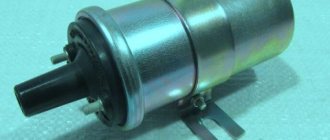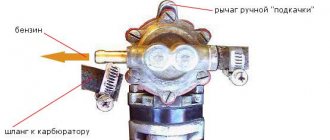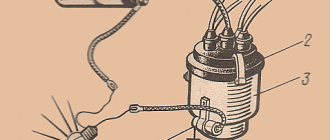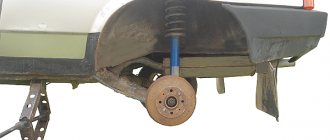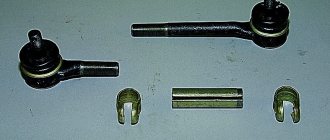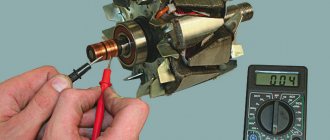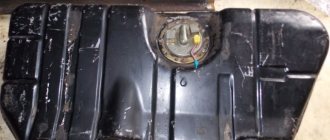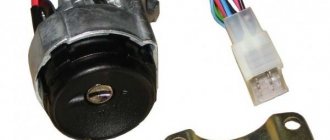The main function and principle of operation of the thermostat on the VAZ 2107
The main task of the thermostat is to prevent the engine temperature from going beyond the specified limits. If the engine heats up above 90°C, the device switches to a special mode that helps cool the engine.
All thermostats on the VAZ 2107 are equipped with three pipes
If the temperature drops below 70°C, the device switches to the second operating mode, which promotes rapid heating of engine parts.
How does a thermostat work?
The “seven” thermostat is a small cylinder, three pipes extend from it, to which tubes with antifreeze are connected. An inlet tube is connected to the bottom of the thermostat, through which antifreeze from the main radiator enters the device. The antifreeze goes through the tube at the top of the device to the S7 engine, into the cooling jacket.
The central element of the thermostat is the valve
When the driver starts the engine after a long period of inactivity, the valve in the thermostat is in the closed position, so that antifreeze can only circulate in the engine jacket, but cannot enter the main radiator. This is necessary in order to warm up the engine as quickly as possible. And the motor, in turn, will quickly heat up the antifreeze circulating in its jacket. When the antifreeze warms up to a temperature of 90°C, the thermostat valve opens and the antifreeze begins to flow into the main radiator, where it is cooled and sent back to the engine jacket. This is a large circle of antifreeze circulation. And the mode in which antifreeze does not enter the radiator is called a small circulation circle.
Thermostat location
The thermostat on the “seven” is located under the hood, next to the car’s battery. In order to get to the thermostat, the battery will have to be removed, since the shelf on which the battery is installed does not allow you to reach the thermostat pipes. All this is shown in the picture below: the red arrow indicates the thermostat, the blue arrow indicates the battery shelf.
The red arrow shows the thermostat mounted on the pipes. The blue arrow shows the battery shelf
How to check the thermostat
You can diagnose the thermostat without involving specialists. The procedure for checking it is quite simple, but to do this the part will need to be dismantled. We will consider the process of removing it from the engine below. Now let’s imagine that we have already done this and the thermostat is in our hands. By the way, this could be a new, just purchased device, or restored by boiling in oil.
To test the thermostat, we only need a kettle with boiling water. We place the device in the sink (sink, pan, bucket) so that the pipe connecting the part to the engine is at the top. Next, pour a small stream of boiling water from the kettle into the nozzle and watch what happens. First, the water must pass through the bypass valve and pour out from the middle pipe, and after heating the thermoelement and the main valve is activated, from the bottom.
Video: checking the thermostat
Signs of a broken thermostat
Since the main main part of the thermostat is the bypass valve, the vast majority of breakdowns are associated with this part. We list the most common symptoms that should make the driver wary:
- The engine overheat indicator light came on on the dashboard. This situation occurs when the central thermostat valve is stuck and is unable to open. As a result, antifreeze cannot go into the radiator and cool down there; it continues to circulate in the engine jacket and eventually boils;
- After a long period of inactivity, the car is very difficult to start (especially in the cold season). The cause of this problem may be that the central thermostat valve is only opening halfway. As a result, part of the antifreeze goes not into the engine jacket, but into the cold radiator. Starting and warming up the engine in such a situation is extremely difficult, since warming up the antifreeze to the standard temperature of 90°C can take a long time;
- damage to the main bypass valve. As you know, the valve in the thermostat is an element sensitive to temperature changes. Inside the valve there is a special industrial wax that expands greatly when heated. The wax container may lose its seal and its contents will spill into the thermostat. This usually happens as a result of strong vibration (for example, if the “seven” engine constantly “trips”). After the wax leaks out, the thermostat valve stops responding to the temperature, and the engine either overheats or starts poorly (it all depends on exactly what position the leaking valve is stuck in);
- The thermostat opens too early. The situation is still the same: the tightness of the central valve was broken, but the wax did not completely flow out of it, and the coolant took the place of the leaked wax. As a result, there is too much filler in the valve container and the valve opens at lower temperatures;
- damage to the sealing ring. There is a rubber ring on the thermostat that ensures the seal of this device. In some situations the ring may break. Most often this happens if oil gets into the antifreeze due to some kind of breakdown. It begins to circulate in the engine cooling system, reaches the thermostat and gradually corrodes the rubber o-ring. As a result, antifreeze enters the thermostat housing and is constantly present there, regardless of the position of the central valve. The consequence of this is engine overheating.
Checking the Thermostat
The problems described above can appear at any time. To avoid engine overheating and damage, you need to know how to check the thermostat directly on the car and after dismantling it at home.
It is important to know that after starting the engine, the thermostat is still closed and the coolant flows through a small circuit (through the cooling jacket and the stove). This allows the power unit to quickly reach the desired temperature.
As soon as the required level is reached, the valve opens and coolant flows through the main radiator.
Understanding this principle is very important when checking the thermostat.
Therefore, we invite you to familiarize yourself with the diagram.
Let's consider two diagnostic options.
Without dismantling
The easiest way is not to remove the unit, but to check it directly on the car. The main condition is a cold engine.
The diagnostic process begins with starting the power unit and warming it up for 2-3 minutes at idle.
This time is not enough for the engine to warm up and the coolant to circulate in a large circle, so the radiator is not yet connected to the general cooling system.
To check that the system is working correctly, touch the pipe that goes to the top of the main radiator with your hand.
The pipe should be cold, which signals the passage of coolant in a small circle (only through the engine and stove).
Therefore, the valve of the device under test is in the closed position (as it should be at this stage).
Continue to monitor engine cooling system performance. As soon as the coolant warms up to 90 degrees Celsius (can be controlled by the sensor), touch the inlet pipe. The thermostat should be open at this moment.
In this case, the coolant is directed in a maximum circle (encompassing the radiator). In such a situation, the pipe that extends from the radiator will be well heated.
By the way, the lower pipe of the cooling system, extending from the radiator, will also be hot.
If the condition described above is not met, then we can talk about a breakdown of the thermostat and its incorrect operation (for example, the valve could be jammed). In such a situation, you need to check it and replace it if necessary.
The second option is also possible, when after starting the engine the tube leading to the radiator warms up almost immediately.
One of the reasons is the valve jamming in the open position and, as a result, the coolant moving in a large circle at once.
The result in this case is obvious - the power unit will not operate in normal mode due to the impossibility of reaching normal temperature conditions.
Such a malfunction is not dangerous for the engine, but can lead to increased fuel consumption.
Situations are possible when the valve “hangs” in the middle position, that is, it does not close or open fully. The problem is diagnosed by the long warm-up of the power unit.
It is more difficult to determine a malfunction in “field” conditions.
In this case, checking the thermostat can only be done by dismantling it.
Checking the functionality of the thermostat by removing
If it is not possible to determine the breakdown without dismantling, then proceed as follows:
- pour the antifreeze into a container prepared in advance. In this case, first install the vessel, and then unscrew the drain plug. To speed up the process of coolant release, unscrew the cap on the expansion tank;
- If there is no such plug, then place a container under the lower part of the radiator pipe. loosen the clamp that holds the pipe to the radiator and remove the pipe itself. Wait until the coolant is completely drained into the container, and then proceed to dismantle the thermostat;
- dismantle the outlet pipe;
- take the thermostat and go to the kitchen. There you will need a stove, a saucepan (or any other metal container) and water. Pour in the liquid and set the pan to heat. Then place the assembly in water so that the body part does not touch the walls of the container itself;
- install a special thermometer in the water and monitor changes in its readings, as well as the actions of the valve itself;
- as soon as the desired temperature is reached, the unit should operate and open. This is possible thanks to the precise operation of the device’s working substance (artificial wax). When heated, the wax expands and allows the valve to operate. If it still does not work at the required temperature, then we can draw conclusions about the unsuitability of the entire assembly (we will talk about the operation temperature below);
- remove the thermostat from the water and let it cool. If the node worked earlier, it should close after a while. Again, if this does not happen, then it needs to be changed.
About choosing a thermostat for VAZ 2107
When the standard thermostat on the “seven” fails, the car owner inevitably faces the problem of choosing a replacement thermostat. There are many companies on the market today, both domestic and Western, whose products can also be used in the VAZ 2107. Let’s list the most popular manufacturers.
Gates thermostats
Gates products have been represented on the domestic auto parts market for a long time. The main difference between this manufacturer is the wide range of thermostats produced.
The range of Gates thermostats is very wide
Here are classic thermostats with valves based on industrial wax, and thermostats with electronic control systems created for more modern machines. Relatively recently, the company began producing case thermostats, that is, devices supplied complete with a proprietary case and pipe system. The manufacturer claims that the efficiency of a motor equipped with their thermostat will be maximum. Judging by the consistently high demand for Gates thermostats, the manufacturer is telling the truth. But you have to pay for high reliability and good quality. The price of Gates products starts from 700 rubles.
Luzar thermostats
It will probably be difficult to find a “Seven” owner who has not at least once heard about Luzar thermostats. This is the second most popular manufacturer in the domestic auto parts market. The main difference between Luzar products has always been the optimal price-quality ratio.
Luzar thermostats have an optimal ratio of quality and price
Another characteristic difference is the versatility of the produced thermostats: a device suitable for the “seven” can be installed on the “six”, “kopek” and even “Niva” without any problems. Finally, you can purchase such a thermostat in almost any auto store (unlike Gates thermostats, which cannot be found everywhere). All these points made “Luzarovsky” thermostats incredibly popular among domestic car enthusiasts. The cost of the Luzar thermostat starts from 460 rubles.
Finord thermostats
Finord is a Finnish company specializing in automotive cooling systems. It produces not only various radiators, but also thermostats, which are highly reliable and very affordable. The company does not provide any specific information about the production process of its thermostats, citing trade secrets.
The Finnish company Finord produces good thermostats at a reasonable price
All that can be found on the official website is assurance of the highest reliability and durability of Finord thermostats. Judging by the fact that the demand for these thermostats has remained consistently high for at least ten years, the Finns are telling the truth. The cost of Finord thermostats starts from 550 rubles.
Wahler thermostats
Wahler is a German manufacturer specializing in thermostats for cars and trucks. Like Gates, Wahler provides car owners with a wide range of models, from electronic thermostats to classic ones with industrial wax. All Wahler thermostats are thoroughly tested and are characterized by the highest reliability. These devices have only one problem: their price is very high. The simplest Wahler single-valve thermostat will cost the car owner 1,200 rubles.
Wahler thermostats are high quality and high price
Here we should also mention the counterfeits of this brand. Now they are becoming more and more common. Fortunately, the fakes are made very clumsily, and are given away primarily by the poor quality of packaging, printing and the suspiciously low price of 500–600 rubles per device. A driver who sees a “German” thermostat sold at such a more than modest price should remember: good things have always been expensive.
So which thermostat should a car enthusiast choose for his “Seven”?
The answer is simple: the choice depends only on the thickness of the car owner’s wallet. A person who is not short of money and wants to replace the thermostat and forget about this device for many years can opt for Wahler products. If you don’t have a lot of money, but you want to install a high-quality device and at the same time have time to look for it, you can choose Gates or Finord. And finally, if money is really tight, you can simply install a Luzar thermostat from the nearest auto store. As they say - cheap and cheerful.
Important points
When replacing a thermostat, there are a couple of important nuances that cannot be ignored. Here they are:
- on the latest models of “sevens” (cars 2010 and older), the clamps on the thermostat are not worm-type, but band-type. This means that you won’t be able to remove them with a regular flat-head screwdriver, and to remove them you will have to use a special clamp wrench, which not every car owner has in their garage. If the car owner is the “happy” owner of a thermostat with band clamps, then there is only one way out: go to the store for a tool. A clamp wrench costs about 300 rubles;
A special wrench is required to remove band clamps - Even after draining the antifreeze from the system, personal protective equipment must not be neglected. Please remember: you cannot completely drain the coolant from the machine. Some part of this liquid will still remain in the thermostat pipes and in the thermostat itself. Taking into account the fact that many car enthusiasts prefer to remove thermostats from below, without leaving the inspection hole, antifreeze can easily get into the driver’s eyes. This, in turn, can lead to serious eye irritation and even blindness. Therefore, you should only change the thermostat while wearing safety glasses and gloves.
So, changing the thermostat on the “seven” is not a difficult task. Preparatory procedures take much more time: cooling the engine and completely draining the antifreeze from the system. Nevertheless, even a novice car owner can cope with these procedures. The main thing is to take your time and strictly follow the recommendations given above.
